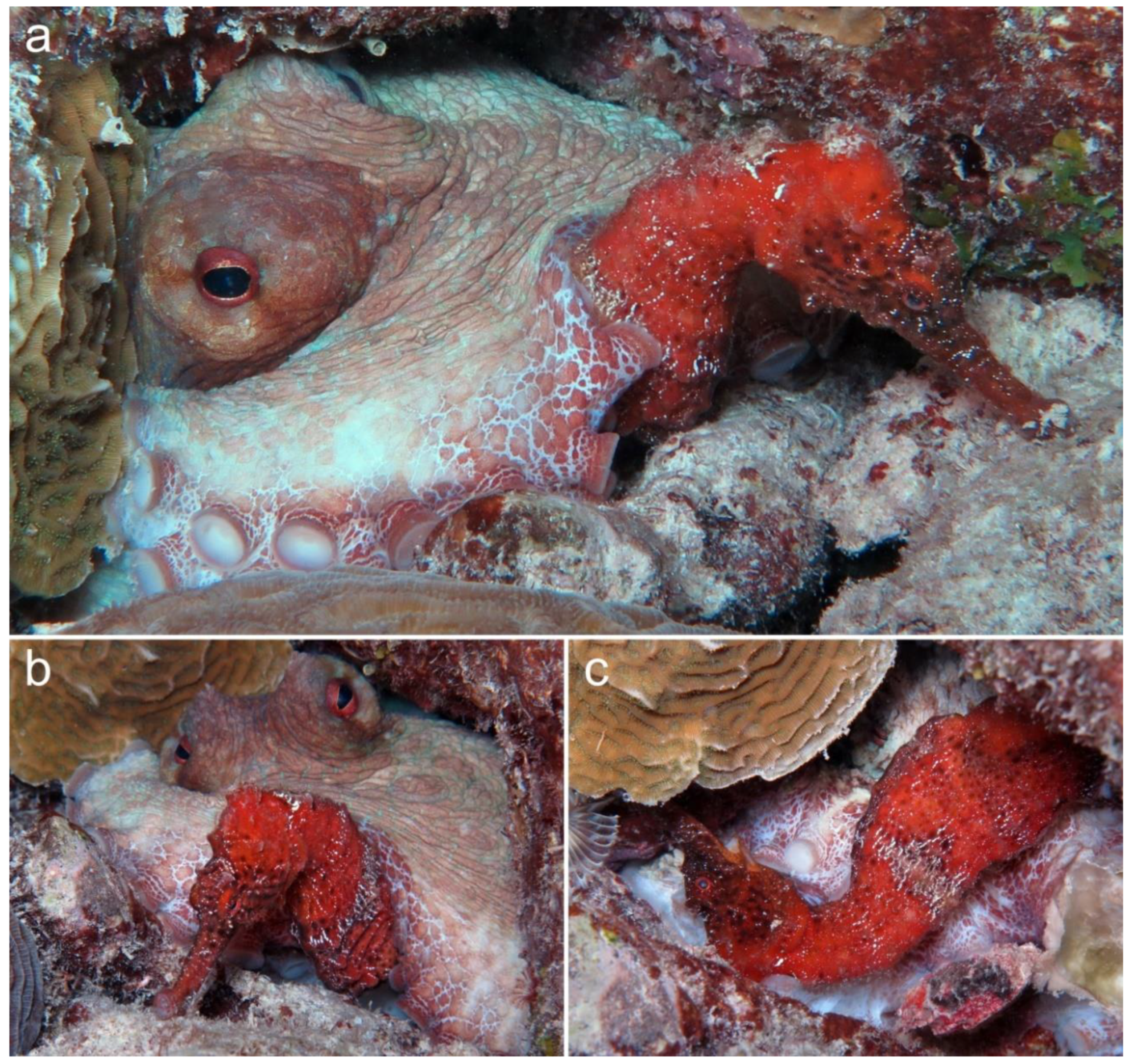Seahorse Predation by Octopuses in the Caribbean and the West Pacific
Abstract
:Supplementary Materials
Author Contributions
Funding
Institutional Review Board Statement
Data Availability Statement
Acknowledgments
Conflicts of Interest
References
- Evanson, M.; Foster, S.J.; Wisedel, S.; Vincent, A.C.J. Tracking the International Trade of Seahorses (Hippocampus Species); Fisheries Centre Research Reports 19; University of British Columbia: Vancouver, BC, Canada, 2011; p. 94. [Google Scholar]
- Rosa, I.L.; Defavari, G.R.; Alves, R.R.N.; Oliveira, T.P.R. Seahorses in traditional medicines: A global overview. In Animals in Traditional Folk Medicine; Alves, R.R.N., Rosa, I.L., Eds.; Springer: Berlin, Germany, 2013; pp. 207–240. [Google Scholar] [CrossRef]
- Chen, L.; Wang, X.; Huang, B. The genus Hippocampus—A review on traditional medicinal uses, chemical constituents and pharmacological properties. J. Ethnopharmacol. 2015, 162, 104–111. [Google Scholar] [CrossRef] [PubMed]
- Koning, S.; Hoeksema, B.W. Diversity of seahorse species (Hippocampus spp.) in the international aquarium trade. Diversity 2021, 13, 187. [Google Scholar] [CrossRef]
- Foster, S.J.; Kuo, T.C.; Wan, A.K.Y.; Vincent, A.C.J. Global seahorse trade defies export bans under CITES action and national legislation. Mar. Policy 2019, 103, 33–41. [Google Scholar] [CrossRef]
- Foster, S.J.; Vincent, A.C.J. Holding governments accountable for their commitments: CITES review of significant trade for a very high-volume taxon. Glob. Ecol. Conserv. 2021, 27, e01572. [Google Scholar] [CrossRef]
- Kleiber, D.; Blight, L.K.; Caldwell, I.R.; Vincent, A.C.J. The importance of seahorses and pipefishes in the diet of marine animals. Rev. Fish Biol. Fish. 2011, 21, 205–223. [Google Scholar] [CrossRef]
- Harasti, D.; Martin-Smith, K.; Gladstone, W. Does a no-take marine protected area benefit seahorses? PLoS ONE 2014, 9, e105462. [Google Scholar] [CrossRef] [Green Version]
- Ternes, M.L.F.; Gerhardinger, L.C.; Schiavetti, A. Seahorses in focus: Local ecological knowledge of seahorse-watching operators in a tropical estuary. J. Ethnobiol. Ethnomed. 2016, 12, 1–12. [Google Scholar] [CrossRef] [Green Version]
- Mastrangelli, A.; Silveira, R.B.; Burato, M.; Baldassin, P.; Werneck, M.R. First report of Lepidochelys olivacea feeding on Hippocampus patagonicus in Brazil. Mar. Turtle Newsl. 2019, 159, 26–27. [Google Scholar]
- Silveira, R.B.; Silva, J.D.S. Presence of the seahorse Hippocampus reidi (Pisces: Syngnathidae) in diet of marine fish in Northeastern Brazil. Oceanogr. Fish. Open Access J. 2020, 12, 5557830. [Google Scholar] [CrossRef]
- Lourie, S.A.; Pritchard, J.C.; Casey, S.P.; Ky, T.S.; Hall, H.J.; Vincent, A.C.J. The taxonomy of Vietnam’s exploited seahorses (family Syngnathidae). Biol. J. Linn. Soc. 1999, 66, 231–256. [Google Scholar] [CrossRef]
- Foster, S.J.; Vincent, A.C.J. Life history and ecology of seahorses: Implications for conservation and management. J. Fish Biol. 2004, 65, 1–61. [Google Scholar] [CrossRef]
- Ambrose, R.F.; Nelson, B.V. Predation by Octopus vulgaris in the Mediterranean. Mar. Ecol. 1983, 4, 251–261. [Google Scholar] [CrossRef]
- Bennice, C.O.; Brooks, W.R.; Hanlon, R.T. Behavioral dynamics provide insight into resource exploitation and habitat coexistence of two octopus species in a shallow Florida lagoon. J. Exp. Mar. Biol. Ecol. 2021, 542–543, 151592. [Google Scholar] [CrossRef]
- Taylor, P.B.; Chen, L.C. The predator-prey relationship between the octopus (Octopus bimaculatus) and the California scorpionfish (Scorpaena guttata). Pac. Sci. 1969, 23, 311–316. [Google Scholar]
- Crocetta, F.; Shokouros-Oskarsson, M.; Doumpas, N.; Giovos, I.; Kalogirou, S.; Langeneck, J.; Tanduo, V.; Tiralongo, F.; Virgili, R.; Kleitou, P. Protect the natives to combat the aliens: Could Octopus vulgaris Cuvier, 1797 be a natural agent for the control of the lionfish invasion in the Mediterranean Sea? J. Mar. Sci. Eng. 2021, 9, 308. [Google Scholar] [CrossRef]
- Villanueva, R.; Perricone, V.; Fiorito, G. Cephalopods as predators: A short journey among behavioral flexibilities, adaptions, and feeding habits. Front. Physiol. 2017, 8, 598. [Google Scholar] [CrossRef] [PubMed] [Green Version]
- O’Brien, C.E.; Bennice, C.O.; Leite, T. A field guide to distinguishing Octopus insularis and Octopus americanus (Octopoda: Octopodidae). Zootaxa 2021, 5060, 589–594. [Google Scholar] [CrossRef] [PubMed]
- Sauer, W.H.H.; Gleadall, I.G.; Downey-Breedt, N.; Doubleday, Z.; Gillespie, G.; Haimovici, M.; Ibáñez, C.M.; Katugin, O.N.; Leporati, S.; Lipinski, M.R.; et al. World octopus fisheries. Rev. Fish. Sci. Aquac. 2021, 29, 279–429. [Google Scholar] [CrossRef]
- Short, G.; Harasti, D.; Hamilton, H. Hippocampus whitei Bleeker, 1855, a senior synonym of the southern Queensland seahorse H. procerus Kuiter, 2001: Molecular and morphological evidence (Teleostei, Syngnathidae). ZooKeys 2019, 824, 109–133. [Google Scholar] [CrossRef] [PubMed] [Green Version]



Publisher’s Note: MDPI stays neutral with regard to jurisdictional claims in published maps and institutional affiliations. |
© 2022 by the authors. Licensee MDPI, Basel, Switzerland. This article is an open access article distributed under the terms and conditions of the Creative Commons Attribution (CC BY) license (https://creativecommons.org/licenses/by/4.0/).
Share and Cite
Muller, E.; Harasti, D.; Hoeksema, B.W. Seahorse Predation by Octopuses in the Caribbean and the West Pacific. Diversity 2022, 14, 125. https://doi.org/10.3390/d14020125
Muller E, Harasti D, Hoeksema BW. Seahorse Predation by Octopuses in the Caribbean and the West Pacific. Diversity. 2022; 14(2):125. https://doi.org/10.3390/d14020125
Chicago/Turabian StyleMuller, Ellen, David Harasti, and Bert W. Hoeksema. 2022. "Seahorse Predation by Octopuses in the Caribbean and the West Pacific" Diversity 14, no. 2: 125. https://doi.org/10.3390/d14020125
APA StyleMuller, E., Harasti, D., & Hoeksema, B. W. (2022). Seahorse Predation by Octopuses in the Caribbean and the West Pacific. Diversity, 14(2), 125. https://doi.org/10.3390/d14020125






